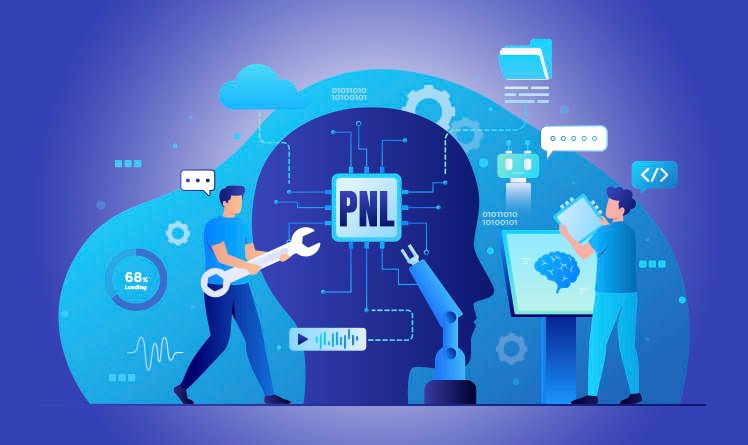What is NLP and how to apply it to improve results

|
Getting your Trinity Audio player ready...
|
Neurolinguistic Programming, or NLP, is a widely used approach to improve communication, behavior and self-awareness.
In this article, we will explore what is NLP and how you can apply it to get best results in your personal and professional life.
What is NLP
THE NLP, or Neuro-Linguistic Programming, is a set of techniques and strategies that focus on understanding the connection between the brain (neuro), language (linguistic) and the behavior patterns we develop based on our experiences.
Above all, the NLP investigates the process of human cognition, that is, it explores how we develop our personal representations of reality from objective facts and how these personal representations influence our approaches to interacting with the environment. In this way, it studies the structure of subjective experience.
Created in the 1970s by Richard Bandler and John Grinder, NLP has been widely adopted in a variety of fields, including psychology, business, therapy, and personal training. Meanwhile, Bandler and Grinder set out on a field mission to investigate the composition of excellence among some of the most prominent therapists of that era, seeking to model the styles, personalities, and patterns of each.
In summary:
Neuro: It refers to the way in which each individual uses their own neurophysiology to translate experience into cognitive processes, both conscious and unconscious, encompassing the relationship between body and mind. Thus, all behaviors result from neurological activities that incorporate the five senses.
Linguistics: It involves the use of verbal communication to give meaning to experience, both in interaction with the individual himself and in communication with others. In this way, linguistic patterns reflect our thinking and our beliefs about ourselves and the world around us.
“Neuro-Linguistic Programming is a set of techniques that help reprogram patterns of thought, language, and behavior to generate positive changes.”
Understanding NLP
1. What NLP involves
THE NLP involves observing and modeling behaviors, beliefs and language patterns of successful people. In this way, this modeling allows other people to learn and apply similar strategies to achieve success in their own lives.
In short, it is a practical and pragmatic approach to improving communication skills, self-awareness and performance.
2. Effective communication with NLP
One of the best known applications of NLP is in improving communication. In this sense, through NLP, you can learn to better understand the needs and perspectives of others and adapt your own communication to be more effective. This is especially valuable in work environments, where clear communication is essential to success.
3. Change in behavior
THE NLP It is also used to help people overcome obstacles and achieve their goals. It definitely offers techniques for identifying and changing unwanted behavior patterns, replacing them with more positive and productive behaviors.
4. Self-knowledge and self-development
Additionally, NLP promotes self-awareness and self-development. It also helps people identify their limiting beliefs and create more empowering beliefs. It can also be used to set clear goals and create strategies to achieve them.
Some basic assumptions of NLP
1. Map is not the territory:
This is the fundamental principle of NLP, which originated from the ideas of Alfred Korzybski (1879-1950), who recognized the difference between our mental representations of the world, called “world maps,” and reality itself. Language is a kind of map or model that we use to summarize and generalize our experiences, allowing us to share them with others.
Thus, each person has their own mental map of reality, and these maps can vary widely. Thus, our perception of reality is a subjective representation and is not reality itself.
There is, therefore, no “correct map” of reality. What exists are more effective maps, which are those that offer more choices. Therefore, it is not the real conditions of the “territory” or of objective reality that impose restrictions or provide opportunities to people, but rather the decisions perceived as available within their own thought models, through their mental representations.
Richard Bandler and John Grinder, in their book “The Structure of Magic”, observe that people who respond creatively and effectively are those who have a representation or model that allows them to see a wide range of possibilities to guide their actions. On the other hand, people who feel limited in their choices fail to see the options and opportunities that present themselves, due to their restricted worldview.
“In NLP, the assumption 'the map is not the territory' means that our perception of reality is just a subjective representation, and not reality itself.”
2. Behaviors have a positive intention:
On the other hand, the NLP assumes that all human behavior has an underlying positive intention, even if the outcome of that behavior seems negative. This means that people do the best they can with the resources they have at the time. It is also important to note that behavior is different from intention. And from the point of view of the person expressing the behavior, it is, or was, a way of adapting to the context and system in which they are inserted.
3. Behavioral flexibility:
THE NLP emphasizes the importance of flexibility in behavior. Being able to adapt and modify behaviors is definitely essential to achieving desired results. After all, in real life, scenarios and contexts are constantly evolving, which means that an action that was effective at one time may no longer generate productive results.
To thrive and survive in the face of these changes, the ability to adapt is essential. Likewise, in systems where the amount of change and complexity is greater, the need for flexibility is heightened.
4. Having a choice is better than having no choice:
Having options at your disposal is preferable to being left without alternatives, and there is invariably a wider range of choices available. Indeed, within the context of systems thinking, one is not restricted to a single approach to achieving a specific goal. Similarly, the principles of Neuro-Linguistic Programming (NLP) emphasize the importance of choice and wholeness, rather than eliminating certain behaviors.
5. The meaning of communication is the response it gets:
THE NLP places emphasis on the communicator's responsibility to ensure that the message is understood by the receiver. From this point of view, if communication is not achieving the desired result, it is the communicator's responsibility to adjust his or her approach.
6. If it is possible for anyone, it is possible for me:
We all have all the resources to act effectively.
7. There is no such thing as failure, only feedback:
NLP encourages people to view “failures” as learning opportunities. As a result, rather than becoming discouraged, people are encouraged to adjust their approach based on the feedback that they receive.
So, all feedback is valuable and provides useful information. Therefore, it is important to pay attention to feedback that we receive to adjust and improve our behavior.
8. Energy goes where attention is:
When we direct our attention to something, our concentration is fixed on it, and as a result, our vitality flows in that direction. In the context of the premises of Neuro-Linguistic Programming (NLP), energy is described as the mobilization of the system.
Thus, this mobilization of the system, when observed in an individual, can manifest itself as effort, worry and even fear on the one hand, while on the other hand, when attention is channeled in a healthy and constructive way, the energy can take the form of motivation, dedication, curiosity and confidence.
Other important NLP concepts:
Report:
Report is the ability to establish an empathic and harmonious connection with others. In short, NLP values the construction of rapport as a fundamental element for effective communication and positive influence.
The way you communicate can vary depending on the situation and the means of communication used, such as telephone, email, or in-person interaction. To build a rapport, Report effective, it is necessary to be aware of how people communicate and how to use gestures, body postures, tone of voice, choice of words, among other elements.
“Rapport in NLP is the ability to create connection, empathy and harmony with another person, generating more effective communication.”
The body and mind are interconnected:
NLP recognizes the connection between the body and mind, believing that changes in posture, breathing and physical expression can affect the mind and vice versa. In this sense, practices such as mindfulness can help accelerate NLP results.
Modeling excellence:
NLP promotes the idea that it is possible to learn from people who are successful in specific areas of life by observing and modeling their thought and behavior patterns.
Applying NLP for better results
To apply NLP in your life and get better results, consider the following tips:
1. Set clear goals:
Use NLP to set clear, specific goals. The more detailed your goals are, the easier it will be to create effective strategies to achieve them.
2. Practice active listening:
Improve your communication skills by practicing active listening. This involves paying full attention to the person you are communicating with, demonstrating empathy (rapport).
3. Change negative patterns:
Identify any negative thought or behavior patterns that are limiting your progress and use NLP techniques to change them into positive patterns.
4. Learn from the best:
Study successful people in your field of interest and apply the strategies and behaviors they use (modeling).
Practical NLP techniques to transform your life
By now, you've understood the principles and applications of Neuro-Linguistic Programming. But the true power of NLP lies in its practice. When we apply these techniques to our daily lives, we can change internal thought patterns, reframe experiences, and create new mental pathways that bring us closer to our goals. Below, we'll look at some of the most well-known NLP techniques and how you can start using them.
Dissociation
The technique of dissociation It's used to lessen the intensity of negative memories or painful experiences. That is, instead of reliving the situation as if you were inside it, you begin to observe it "from the outside," as if watching a movie. This reduces the emotional burden and allows you to analyze the event more rationally.
Practical example: Imagine an argument that still affects you. Close your eyes and visualize the scene as if it were a black-and-white film projected on a movie screen. See yourself sitting in the audience, just watching. This simple shift in perspective causes the negative emotion to weaken.
“Dissociation is an NLP technique that reduces the emotional intensity of negative memories, allowing you to observe them from the outside, as a spectator.”
Resignification
Reframe is to assign new meaning to an experience or belief that previously seemed limiting. The change in interpretation also changes the emotional state and resulting behavior.
Practical example: Losing a job can be seen as a failure or as an opportunity to start over in a career more aligned with your values. By changing how you interpret the situation, you open up space for motivation and growth.
“Resignification is an NLP technique that changes the meaning attributed to an event, transforming a problem into an opportunity.”
Anchoring
THE anchoring is one of the most popular NLP techniques. It involves associating a positive emotional state with a specific stimulus—such as a gesture or word—so that whenever you repeat that stimulus, the positive state is reactivated.
Practical example: Close your eyes and recall a moment when you felt incredibly confident. Relive every detail of that memory—the colors, sounds, and sensations. When you feel the emotion at its peak, close your hand tightly. Repeat the exercise a few times. The next time you need a boost of confidence, close your hand again and notice how the feeling returns.
“Anchoring is an NLP technique that associates a gesture, word or stimulus with a positive emotional state, allowing you to access it when necessary.”
Ericksonian Hypnosis
Although not always considered a “classical” part of NLP, Ericksonian Hypnosis has a strong connection to its origins. Milton Erickson, a psychiatrist and hypnotherapist, inspired Bandler and Grinder in the creation of several linguistic patterns. His approach consists of using metaphors, stories, and indirect language to access the unconscious naturally.
Practical example: Instead of giving a direct order, a therapist might tell a story where the character overcomes a challenge. The listener's unconscious bridges the gap, and the message is internalized more smoothly.
“Ericksonian hypnosis uses metaphors and indirect language to access the unconscious and facilitate internal changes.”
How to integrate these techniques into your daily life
More important than knowing the techniques is applying them consistently. You can start by choosing just one, like anchoring, and practicing it daily for a few minutes. You can also integrate NLP with other practices, such as mindfulness, using mindfulness to observe your mental patterns before applying a change technique.
With each practice, you train your brain to create new neural pathways, strengthening neuroplasticity and expanding your choices in life. NLP isn't a distant theory: it becomes powerful precisely when applied to small, everyday situations.
In short…
Neuro-Linguistic Programming is a powerful tool for improving communication, behavior, and performance in many areas of life. By understanding the principles of NLP and applying them consistently, you can achieve more positive and effective results. NLP not only helps you interact with others, but it also promotes self-awareness and personal growth. So, consider incorporating NLP into your journey of self-development and continuous improvement.
Recommended Reading:
REPROGRAM YOUR MINDSET: Identify your blocks and start your transformation
NLP FAQs
1. What is NLP in a nutshell?
NLP, or Neuro-Linguistic Programming, is a set of techniques that study how the brain, language, and behavior connect to shape the way we think, feel, and act.
2. What is NLP used for in practice?
NLP helps improve communication, increase self-awareness, change limiting behavior patterns, and enhance the achievement of personal and professional goals.
3. What are the best-known NLP techniques?
The best-known techniques are dissociation, reframing and anchoring.
4. Is NLP scientifically proven?
NLP is a practical methodology that combines empirical observations with applied principles. Although controversial within the scientific community, its methods are widely used in coaching, applied psychology, and personal development, with proven results.
5. What is the difference between NLP and traditional psychotherapy?
While traditional psychotherapy often seeks to understand the past and the origin of problems, NLP focuses on practical and quick solutions to change mental and behavioral patterns in the present.
Image: Freepik
Article originally published on 09/12/2023 and updated on the date above.

Marcel Castilho is an expert in neuromarketing, neuroscience, mindfulness and positive psychology. In addition to being an advertiser, he also has a Master's degree in NLP – Neurolinguistic Programming. As the owner and founder of the communications agency VeroCom and also of the digital agency Vero Contents, he has been studying human behavior for over 30 years.



